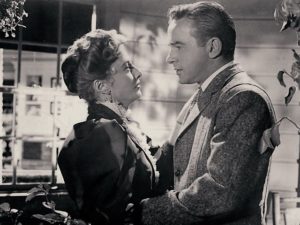STUDIO: Kino Lorber | DIRECTOR: Douglas Sirk | STARS: Barbara Stanwyck, Richard Carlson, Lyle Bettger, Maureen O’Sullivan, Richard Long
RELEASE DATE: Available now | PRICE: DVD None, Blu-ray $17.99
BONUSES: audio commentary by film historian Imogen Sara Smith
SPECS: NR | 80 min. | Drama | 1.37:1 | monaural
The lasting value of Douglas Sirk’s films is that they should not only fulfill the first “obligation” of the Hollywood melodrama — namely, bringing the viewer to tears — but they also contain subtexts about the individual’s social image and their place in their community.
The 1953 feature All I Desire communicates this loud and clear with its take on “the return of the prodigal wife,” in the early 20th century, as incarnated by that great onscreen sufferer, Barbara Stanwyck (The File on Thelma Jordon). Here Stanwyck plays a performer getting by in touring shows and vaudeville who is asked by her daughter to return to the town she left long ago — where her schoolteacher husband (Richard Carlson, The Maze) still lives with their three adolescent children.
The plot runs along the classic lines of a melodrama, as the three children all have different reactions to their mother’s return, with one (Lori Nelson) welcoming her back, another (Marcia Henderson) telling her she should leave, and the youngest (Billy Gray, from TV’s Father Knows Best) not knowing what to think. Complicating matters is that Stanwyck’s character left town because of the stifling nature of her marriage to her drippy husband and because she was having an affair with a local storekeeper (Lyle Bettger).
 These cross-currents ensure that film stays at a high level of angst for its tight 80 minutes — a B-movie running time for a lower-budgeted star vehicle. And a star vehicle it is, as Stanwyck delivers a performance that incorporates elements from her roles as hardboiled dames (Baby Face, Ball of Fire) and suffering mothers (Stella Dallas).
These cross-currents ensure that film stays at a high level of angst for its tight 80 minutes — a B-movie running time for a lower-budgeted star vehicle. And a star vehicle it is, as Stanwyck delivers a performance that incorporates elements from her roles as hardboiled dames (Baby Face, Ball of Fire) and suffering mothers (Stella Dallas).
The other outstanding aspect of the film — seen to best advantage here in a sparkling new restoration for Blu-ray — is the crisp B&W photography by Carl Guthrie (Caged) and the masterfully “distanced” compositions by Sirk. We view the family through various “frames” (windows, doorways, banisters) and Stanwyck is seen as “apart” from her family because she views them through these frames.
Sirk refined this approach throughout the Fifties and was able to “comment” on his plot using these visuals. In All I Desire it most certainly strengthens the viewer’s identification with Stanwyck.
The stylized visuals are discussed in the audio commentary by film historian Imogen Sara Smith. Most interesting of Smith’s observations is that the subplot about Stanwyck’s affair is the worst part of the script.
Smith asserts that Sirk was able to cope with the cornier plotlines in the melodramas he was assigned by producer Ross Hunter by playing with them on a stylistic level. He “almost undermines the corniness rather than trying to modulate it” in the affair subplot by “adopting a flat [visual] style that leans into the phoniness” of that plot strand — thus creating memorable imagery to adorn the most routine material in the picture.
All I Desire was released in tandem with another Sirk-directed Stanwyck vehicle, the somber and gorgeous There’s Always Tomorrow. Kino Lorber also recently released an uncharacteristic Sirk picture that is very worthy of reexamination, Taza, Son of Cochise (released on BRD with both the restored 3-D and standard 2-D versions of the film on the same disc).
|
Buy or Rent All I Desire
on Blu-ray
|
|---|
 | Audio
| Audio
Leave a Reply